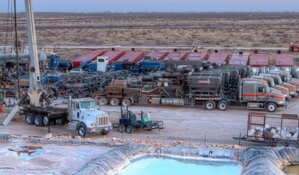Kevin Smith: We've had significant yield compression over the last 12 months due to a myriad of factors. With the 10-year Treasuries getting down to such low levels and the uncertainty in the stock market, there is strong overall demand for "yield and shield." People like MLP investments. Historically, they've performed well and people are uncertain about further tax implications going forward. Investors appreciate a tax-sheltered vehicle that produces a lot of income. We have seen great demand, as well as significant distribution growth through the whole MLP sector in general.
I closely cover the upstream MLP space. We haven't seen many distribution increases in that subsector over the last year, though we did see Linn Energy, LLC (NASDAQ:LINE) increase its distribution last quarter, and I think we will see more of that going forward. But, yes, yields have definitely tightened over the last 12 months.
TER: All right, so yields are down in 2010 but how do they directly compare with 2009 yields?
KS: That's a great question. In 2009, the yields were averaging roughly 9%. Now, they're down to about 7%. So, we've seen a yield compression of about 200 basis points.
TER: But year-to-date, the MLP sector is up 18%. So, even though the yields are less robust than they used to be, people are still coming into MLPs in a fierce way.
KS: Well, you've seen distribution growth and yield compression. And we've seen a lot of new sector in-flows—fund flows with different ETFs and closed-end funds—putting money into the MLP space.
TER: How is the extra money that's pouring in to the MLP market changing things?
KS: Well, extra investor demand is definitely driving up prices as far as valuations and driving down yields; it's also boosting demand for new MLPs. Additionally, we are seeing new MLPs being formed in both the midstream and the upstream space. We've seen a significant amount of acquisitions in this space and investor demand, as well as lowering cost of capital through lower yields, which will spur activity in this space.
TER: In a recent report on MLPs and energy in general, you talked about ethylene plant outages and the impact those outages could have on natural gas liquids (NGLs). What's the update there?
KS: That's primarily Darren Horowitz's area, but what we've seen is some unexpected downtime at ethylene plants during the second quarter and that lowered ethane pricing. We've seen a strong boost in NGL production from some of these shale plays, specifically the Eagle Ford Shale and, to a lesser extent, the Granite Wash and the Marcellus. These shale plays have significantly increased NGL production in the U.S., and one of the largest mixes of the NGLs is ethane. It is roughly 45% of the NGLs production.
Chemical companies primarily use ethane to produce plastics. So, when a series of ethylene plants shut down, that ultimately lowered the demand for ethane in the second quarter. Now, some people are worried that U.S. ethane production will exceed demand and that the chemical companies won't be able to ramp-up fractionator facilities in order to turn it into ethylene, which is used to make plastics.
But we have seen ethane prices strengthen in the third quarter and going into the fourth quarter as these plants have come back online, boosting demand.
TER: What are some MLPs that could be affected by that?
KS: Enterprise Products Partners, L.P. (NYSE:EPD) is definitely well positioned to take advantage of the bullish ethylene environment and some of the others. Williams Partners, L.P. (NYSE:WPZ) is going to be positively impacted, as well as any other gas processors. However, I am more focused on the upstream MLPs than the midstream ones.
TER: What are some of the trends going on right now in the MLPs space?
KS: In the upstream MLP space, we're continuing to see massive size acquisitions and divestitures. The upstream MLP space has done over $2 billion in acquisitions this year, which is pretty sizeable considering the collective market cap is roughly $14 billion.
I believe there still is an enormous amount of consolidation in the E&P space that will take place over the next 5–10 years. Just look at the U.S. stripper wells, which are basically marginal wells that really don't have a lot of production growth but are maintaining stable production profiles and generating a ton of cash flow. They supply roughly 5% of the U.S. onshore production of oil and about 7% of the natural gas. In a lot of ways, these assets have no business being in an exploration and production (E&P) C corp but it makes a lot of sense for the upstream MLPs to hold these assets because it's a tax-efficient vehicle. This is a way for E&P C-corps to monetize properties and redeploy that capital into what they are really being paid to do, which is drill, find new reserves and increase production.
I think a lot of these shale gas producers will continue to divest their mature properties and monetize those producing assets to help fund their capital spending programs. That pace has the potential to pick up in 2011 because most of the oil and gas E&P companies aren't going to be hedged as effectively as they were going into this year. We saw a nice little spike in gas last year in November and they were able to lock into hedges. So, the hedging profiles for most the E&P companies are going to have lower strike prices and, therefore, they'll have less operating cash flow, all things being equal. And they'll most likely have to divest more properties to maintain the sort of spending levels the company is used to. Historically, E&Ps reinvest roughly 130% of their cash flow, so the question becomes: Where do they get the excess cash? We think a lot of it is going to come from property divestitures.
TER: Could you briefly summarize the upstream, midstream and downstream MLP spaces?
KS: The upstream MLPs are the oil and gas production companies; they're the ones that go out and drill the wells and actually produce the hydrocarbons.
The midstream segment kind of picks up the oil and gas to process them, which basically cleans and separates them, and then ultimately transports them down to the downstream segment—the refiners and end users—and even the utility companies—depending on whether it's an oil or gas product.
Historically, the upstream space was not seen as being suitable as an MLP segment due to its declining production profile. But the industry has done quite a bit to offset that. The industry has packaged upstream properties into MLP vehicles with four or five years of hedged production. They then try to do a certain number of acquisitions every year, as well as a little bit of organic growth to offset the natural production decline associated with the underlying assets.
TER: Within that space, what are some companies you're recommending to institutional and retail investors?
KS: We've been recommending Linn Energy, which is our only strong buy-rated name in the upstream MLP space currently. The reasons are threefold: 1) The partnership's unparalleled organic growth potential due to its horizontal Granite Wash drilling program; 2) Linn has one of the best hedge books in the industry with approximately 100% of its natural gas production hedged through 2015; and 3) The partnership has an extremely active acquisition program, targeting transactions in the $300–$500 million range. In this time of constrained liquidity for E&P C-corps. Linn is really one of a handful of companies that could finance it and get that size of a deal done. But the main reason we like Linn is because of its organic growth potential. It is drilling horizontal Granite Wash wells that have payback periods of six–nine months; so, essentially, it's buying EBITDA at less than 1x while trading on an EV/EBITDA basis of closer to 9x—so, highly accretive transactions.
TER: That sounds positive. You also have a buy rating on El Paso Pipeline Partners, L.P. (NYSE:EPB) with a target of $38. What's supporting that rating?
KS: Well, that's our dividend discount model—which uses our distribution-growth assumptions and discounts that back based on our cost of capital assumption. El Paso Pipeline Partners is blessed with a significant amount of dropdowns from its parent, El Paso Corporation (NYSE:EP), and we think, because of the El Paso C-corp's financing needs, EP will continue to drop down pipelines at a decent pace. The partnership will continue to deliver significantly high distribution growth; it also has a high coverage ratio and a very sustainable business model on the pipeline, very stable earnings in gas and cash flow.
TER: Are there any near-term catalysts for an uptick in the price?
KS: Well, the company recently announced a $1 billion dropdown; so, we would expect maybe two–three more dropdowns in 2011. But, as far as near term, it's probably going to integrate the assets it has at this point. So, don't expect El Paso to do anything until maybe late Q111 or early Q211 at the earliest.
TER: What is a dropdown?
KS: That is where the MLP's parent company, in this case El Paso, sells assets to the partnership, El Paso Pipeline Partners.
TER: Besides Linn and El Paso, are there some other companies that have a positive outlook?
KS: Yes, we're very positive on EV Energy Partners, L.P. (NASDAQ:EVEP) and Legacy Reserves, L.P. (NASDAQ:LGCY)—but for different reasons. EV Energy Partners has a large private equity sponsor in EnerVest Management Partners Ltd. We believe that over the next few years, as the private equity funds mature, EV Energy Partners stands in line to acquire those assets. It also made a strong play into the Barnett Shale recently; so, we are going to be closely watching both the organic production and the integration of those assets as we see upstream MLPs venture into different areas of more mature production. As the Barnett's production profile rolls over, and the producing assets have got four–five years of production history, we wouldn't be surprised to see more C-corps exit out of the Barnett as that capital goes to work in more emerging shale plays.
Legacy Reserves, which is consolidator of Permian Basin properties, had another strong year of acquisitions in 2010; announcing and/or completing more than $250 million in acquisitions. As you may know, the Permian Basin is one of the hottest basins in the U.S. right now due to the oily nature of the basin. Additionally, operators in this area have recently started targeting new formations for horizontal development near Legacy's acreage. Due to the partnership's organic growth program and its highly accretive 2010 acquisitions, we expect Legacy will be able to increase its distribution in the first half of 2011.
TER: Some MLPs are acquiring their general partners (GPs), and it's certainly something that they're doing in advance of the carried interest legislation making its way through the House. What's the status of that legislation?
KS: I haven't heard any updates, but everything the National Association of Publicly Traded Partnerships has said is that the legislation wasn't written to impact publicly traded partnerships and that it's working diligently to make certain that doesn't impact them. We've seen a lot of consolidation of the GPs at the LP level but, for the most part, that's been more in line to minimize any sort of capital advantages, as well as to allow for further distribution growth.
TER: Will that continue?
KS: I think it will. I think GPs will continue to be bought by the LP unitholders. The pace and timing are always uncertain but, once partnerships get into the high splits, it becomes difficult for them to have a cost-of-capital advantage. In fact, there is usually a cost-of-capital disadvantage.
TER: Does that mean there's a structural problem with the vehicle itself?
KS: No, some of the MLPs that I like the most are LLCs; they don't have GPs. Linn Energy is a great example. The company was formed as an LLC and, therefore, doesn't have a GP. So, all investors share in the distribution growth equally. The problem for companies that have IDRs is that once they get into the high splits, it becomes prohibitive for them to do further accretive transactions.
TER: Do you typically change ratings on MLPs after they buy their GPs?
KS: Obviously, it depends on the multiple at which they took out the GP and how much leverage and debt they had to take on. Once they've eliminated the GP hurdle, they should have a positive outlook going forward because it kind of lowers the bar on the cost of capital for further acquisitions. It's become a necessary evil in a lot of ways after a company gets into high splits.
TER: What are some MLPs that you could see taking out their GPs?
KS: That's something that Williams Partners would ultimately look at, at some point in time. There are others that Darren works on, but none of the other upstream MLPs is likely to do that in the near term.
TER: Well, a recent Raymond James research report cites Crosstex Energy, L.P. (NASDAQ:XTEX) as being one. Why would it make sense for Crosstex to buy its GP?
KS: For the same reasons—once its GP gets into the high splits, it needs to purchase the GP in order to increase its distribution effectively.
TER: Do you have any parting thoughts on the MLP sector?
KS: Over the long term, the MLP sector offers a very attractive risk/reward proposition, especially when you consider the tax-deferred portion of the yield and the fact that you're going to see a significant amount of retirees looking for yield and shield. So, we remain bullish on MLPs even though yields have tightened quite a bit. At this point, you might want to slowly add to positions rather than jumping in feet first because we wouldn't be surprised to see more attractive entry points down the road. But we also think you're going to continue to see institutional money flow into this space once those institutions look at the track record and growth potential of MLPs. It's pretty darn compelling.
TER: Right, but institutions are already coming into the sector in an unprecedented way. It's the biggest shift from retail to institutional investors this sector has ever seen.
KS: We also saw a pretty big shift in 2008, and then we saw an exit. I think institutional investors are slowly waking up to MLPs as an asset class. They are trying to find an area that can top this on a risk-adjusted basis and they are having a tough time. Therefore, they're jumping in and getting over the accounting burden of the K1s versus the 1099s.
TER: You said you saw a fair shift or inflow of capital from institutional investors in 2008, but then they left. It's as if they came in only for the short term. Do you fear a similar thing could happen again?
KS: In 2008 and 2007, they came in with a lot of leverage and ultimately got blown out when things went badly. But institutions are not leveraged to the gills the way they were in 2008. And I think we've seen a smarter and more-stable class of investors on the institutional side. From everything I've seen, people are in it for the long term.
TER: Thanks, Kevin, we appreciate your insights.
Kevin Smith, who has been with Raymond James for four years, is an exploration and production (E&P) analyst that specializes in upstream MLP partnerships. Previously, he worked for Wells Fargo in its E&P Corporate Lending group in Houston where he was responsible for credit analysis for mid- and large-cap E&P companies. Prior to joining Wells Fargo, Kevin was a power trader at Reliant Resources for three years where he traded electricity on the company's East power desk. Kevin holds a bachelors degree in business administration (BBA) from Baylor University and a masters of business administration (MBA) from Texas A&M University. He is an avid tennis player and jogger.
Want to read more exclusive Energy Report interviews like this? Sign up for our free e-newsletter, and you'll learn when new articles have been published. To see a list of recent interviews with industry analysts and commentators, visit our Expert Insights page.
DISCLOSURE:
1.) Brian Sylvester of The Energy Report conducted this interview. He personally and/or his family own shares of the following companies mentioned in this interview: None.
2.) The following companies mentioned in the interview are sponsors of The Energy Report: Enterprise Products Partners.
3.) Kevin Smith: I personally and/or my family own shares of the following companies mentioned in this interview: None. I personally and/or my family am paid by the following companies mentioned in this interview: None. *Regulatory Disclosures for Kevin Smith as of 12/6/10*
Visit The Energy Report’s MLP Insights to learn more.









































